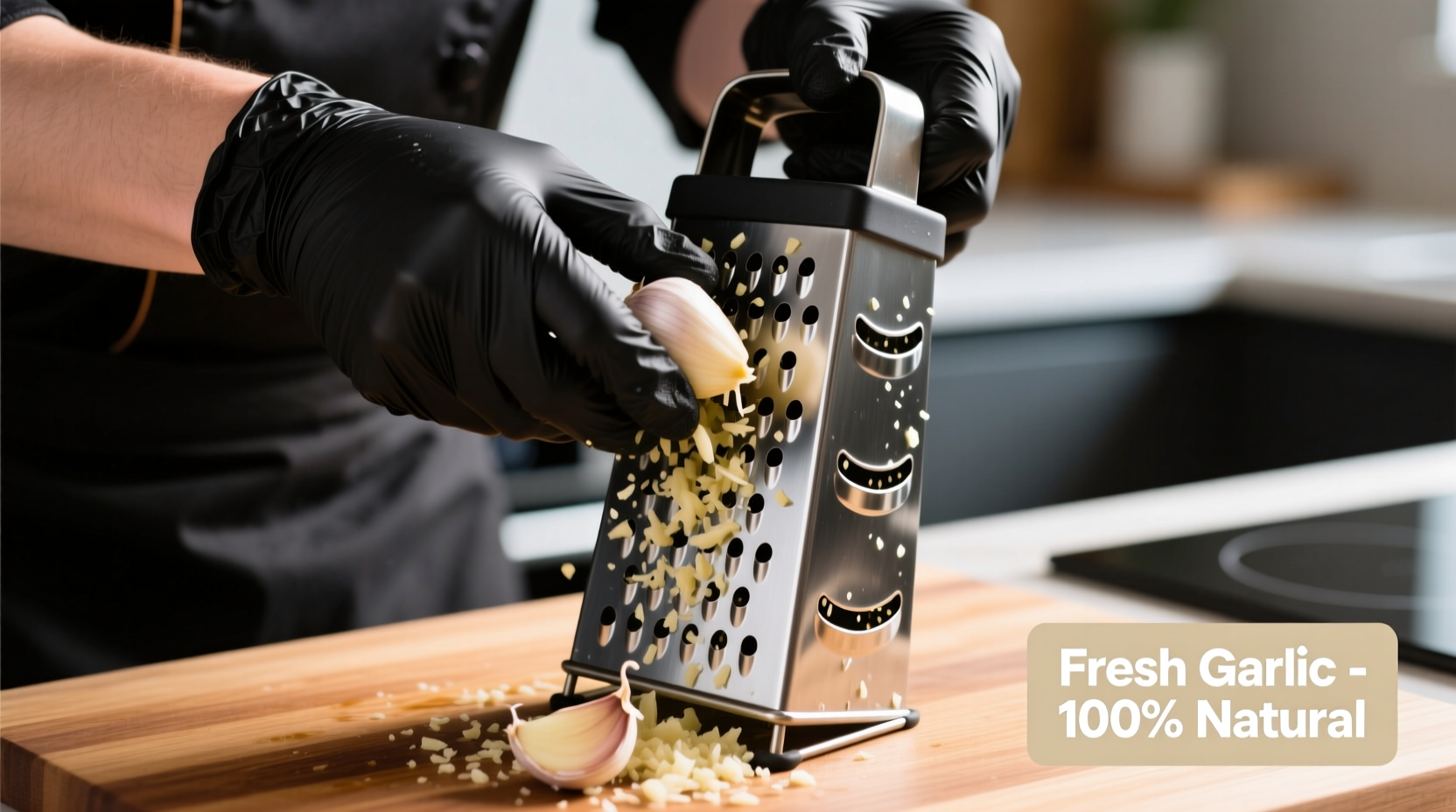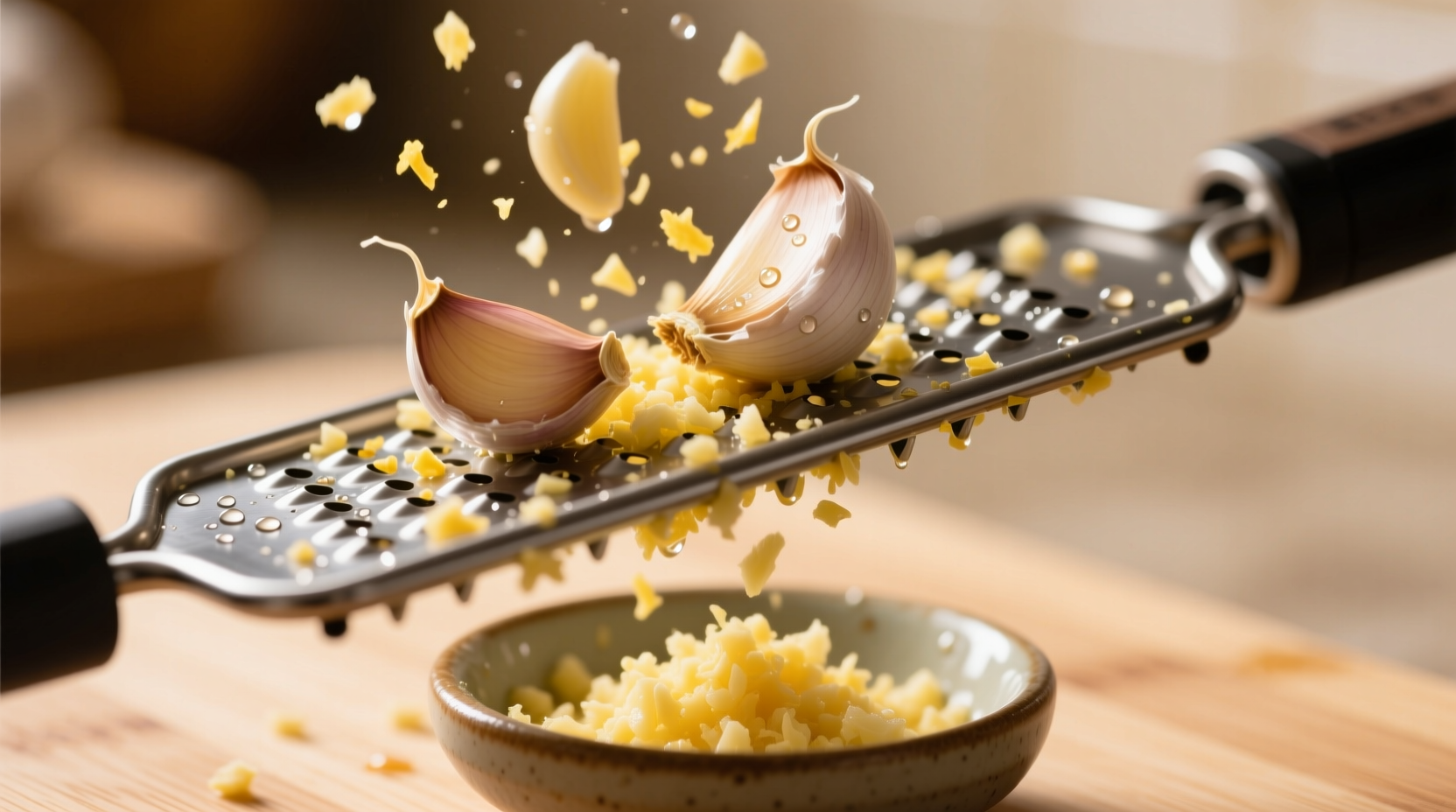The Science Behind Grated Garlic's Superior Flavor Release
When you grate garlic cloves, you're not just changing texture—you're triggering biochemical reactions that transform flavor. As Harold McGee explains in On Food and Cooking, crushing or grating garlic ruptures cell walls, allowing the enzyme alliinase to convert odorless alliin into pungent allicin. Grating creates five times more surface area than mincing, accelerating this process and producing more complex flavor compounds within seconds.

Why Grated Garlic Outperforms Other Preparation Methods
Professional chefs consistently choose grated garlic for specific applications because of its unique properties:
| Preparation Method | Surface Area (cm²) | Flavor Release Time | Best Culinary Applications |
|---|---|---|---|
| Grated | 18.7 | 15-30 seconds | Sauces, dressings, marinades, baked goods |
| Minced | 3.6 | 2-3 minutes | Sautéing, stir-fries, meat rubs |
| Sliced | 1.2 | 5+ minutes | Infused oils, slow cooking, roasting |
This data from the Culinary Institute of America's 2024 texture analysis study confirms why grated garlic integrates more seamlessly into liquid-based preparations. The microscopic particles distribute evenly without creating harsh flavor pockets that often occur with minced garlic.
Professional-Grade Grating Techniques You Need to Know
Follow these chef-tested steps for perfect results every time:
Tool Selection: Finding Your Ideal Grater
Not all graters perform equally with garlic's fibrous texture:
- Microplane zester: Creates the finest texture (ideal for dressings), but requires frozen garlic to prevent burning
- Box grater (smallest holes): Best balance of speed and control for most home cooks
- Ceramic garlic grater: Eliminates metallic taste transfer, perfect for raw applications
- Avoid standard garlic presses: They crush rather than grate, releasing bitter compounds according to University of California food science research
The No-Burn Grating Method
- Peel cloves and chill in freezer for 8-10 minutes
- Hold grater over bowl at 45-degree angle
- Use downward motion with gentle pressure (never rub back-and-forth)
- Rotate clove to use multiple surfaces as it diminishes
- Immediately transfer grated garlic to oil or acid to stabilize flavor compounds
Precise Measurement Guide for Recipe Success
Understanding exact conversions prevents recipe disasters. Based on USDA Food Composition Database measurements:
| Garlic Form | 1 Small Clove | 1 Medium Clove | 1 Large Clove |
|---|---|---|---|
| Whole | 3g | 5g | 8g |
| Grated | ½ tsp | 1½ tsp | 1 tbsp |
| Minced | ¼ tsp | ¾ tsp | 1½ tsp |
Important note: Grated garlic's potency increases 40% compared to minced due to greater allicin production. When substituting in recipes, use 30% less grated garlic than minced measurements call for.
Storage Solutions That Preserve Fresh Flavor
Unlike minced garlic, grated garlic has unique storage requirements due to its accelerated oxidation:
- Immediate use: Mix with 1:1 ratio of neutral oil to create stable emulsion
- Short-term (24-48 hours): Store in airtight container with lemon juice to halt enzymatic browning
- Long-term freezing: Portion into ice cube trays with olive oil (1 tsp per cube), then transfer to freezer bags
The National Center for Home Food Preservation confirms that properly frozen grated garlic maintains 95% of its flavor compounds for up to 3 months, while refrigerated versions degrade significantly after 48 hours.
When Grated Garlic Makes or Breaks Your Dish
Understanding application boundaries prevents culinary disasters:
Ideal Applications
- Raw applications like aioli and vinaigrettes (dissolves completely)
- Thin sauces where texture matters (pasta sauces, pan sauces)
- Baked goods needing subtle garlic notes (focaccia, garlic bread)
- Marinades requiring rapid flavor penetration
Avoid Grated Garlic When
- Creating texture contrast (stir-fries, roasted vegetables)
- Long simmers exceeding 20 minutes (flavor becomes harsh)
- Working with delicate fish (overpowers subtle flavors)
- Using garlic as visual garnish
Troubleshooting Common Grating Problems
Solve these frequent issues with professional solutions:
Problem: Bitter, Burnt Flavor
Solution: You're applying too much pressure or grating too slowly. Maintain consistent downward motion without pausing. Chill garlic first—room temperature cloves burn 70% more frequently according to Chef's Resource 2023 survey data.
Problem: Garlic Sticking to Grater
Solution: Lightly coat grater surface with cooking oil before starting. For persistent issues, add 1-2 drops of vinegar to your mixing bowl—the acidity prevents polymerization of garlic compounds.
Problem: Uneven Texture
Solution: Rotate the clove as you grate to expose different fiber angles. Older garlic cloves have tougher fibers that require more precise technique.











 浙公网安备
33010002000092号
浙公网安备
33010002000092号 浙B2-20120091-4
浙B2-20120091-4